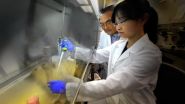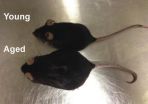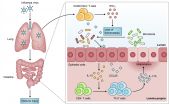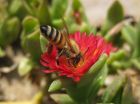Nasal spray vaccine has potential for long-lasting protection from ebola virus
2014-11-03
San Diego — A nasal vaccine in development by researchers at The University of Texas at Austin has been shown to provide long-term protection for non-human primates against the deadly Ebola virus. Results from a small pre-clinical study represent the only proof to date that a single dose of a non-injectable vaccine platform for Ebola is long-lasting, which could have significant global implications in controlling future outbreaks. This work is being presented Nov. 5 at the 2014 American Association of Pharmaceutical Scientists (AAPS) Annual Meeting and Exposition, ...
Biological fat with a sugar attached essential to maintaining the brain's supply of stem cells
2014-11-03
AUGUSTA, Ga. – Fat and sugar aren't usually considered healthy staples, but scientists have found that a biological fat with a sugar attached is essential for maintaining the brain's store of stem cells.
Neural stem cells help the brain develop initially, then repopulate brain cells lost to usual cell turnover as well as to a trauma or malady, such as a head injury or stroke.
While the cell population and activity decrease as a natural part of aging, scientists at the Medical College of Georgia at Georgia Regents University are studying how neural stem cells ...
School environment affects teacher expectations of their students
2014-11-03
The school environment in which teachers work is related to their expectations of students, according to a new study by researchers at the University of Montreal. "It is known that low teacher expectations are negatively associated with student achievement and school effectiveness. While we know that expectations are primarily determined by the specific characteristics of teachers, we have shown that the school environment also plays a determining role," says lead author of the study, Marie-Christine Brault, a post-doctoral researcher at the university's Institut de recherche ...
Beliefs about the soul and afterlife that we acquire as children stick with us
2014-11-03
What we believed as children about the soul and the afterlife shapes what we believe as adults – regardless of what we say we believe now, according to a new Rutgers study.
"My starting point was, assuming that people have these automatic – that is, implicit or ingrained – beliefs about the soul and afterlife, how can we measure those implicit beliefs?," said Stephanie Anglin, a doctoral student in psychology in Rutgers' School of Arts and Sciences.
Her research, "On the Nature of Implicit Soul Beliefs: When the Past Weighs More Than the Present," ...
Women with bipolar disorder at 50 percent greater risk of delivering preterm babies
2014-11-03
TORONTO, ON, Nov. 3, 2014 — Women who have been previously hospitalized for bipolar disorder are nearly twice as likely to have premature babies compared to women without a history of mental illness, according to a new study by researchers at Women's College Hospital and the Institute for Clinical Evaluative Sciences (ICES).
The study, published today in the American Journal of Obstetrics and Gynecology, shows pregnant women with bipolar disorder are at greater risk of having premature babies and other serious complications. While the study did not examine the ...
Wrangling data flood to manage the health of streams
2014-11-03
Today's natural resource manager tending to the health of a stream in Louisiana needs to look upstream. Way upstream - like Montana. Michigan State University (MSU) scientists have invented a way to more easily manage the extensive nature of streams.
There are 2.6 million stream reaches in the contiguous United States that are intricately interconnected. It's impossible to address the health of one reach without knowing what's happening upstream.
Science, wielding geographic information systems, has obliged with data on geology, climate, pollution and land use. But ...
Obesity a liability in cancer immunotherapy
2014-11-03
Packing on the pounds may lead to dangerous inflammation in response to anti-cancer treatment, according to a study by William Murphy and colleages at UC Davis. The study, published in The Journal of Experimental Medicine, shows that overweight mice develop lethal inflammation in response to certain anti-cancer therapies, suggesting a possible link between body weight and adverse side effects in cancer patients treated with similar protocols.
Cancer treatment has been revolutionized by new approaches aimed at stimulating the body's own immune system to fight off tumor ...
On the throne with the flu
2014-11-03
Flu infection has long-ranging effects beyond the lung that can wreak havoc in the gut and cause a dreaded symptom, diarrhea, according to a study published in The Journal of Experimental Medicine.
Gastrointestinal symptoms are often seen with flu infection, but because the virus only grows in lung cells, it's unclear how intestinal symptoms develop. Researchers in China now show that flu infection in mice prompts responding immune cells in the lung to alter their homing receptors, causing them to migrate to the gut. Once there, they produce the antiviral mediator IFN-γ, ...
Immunotherapy for cancer toxic with obesity
2014-11-03
(SACRAMENTO, Calif.) — Immunotherapy that can be effective against tumors in young, thin mice can be lethal to obese ones, a new study by UC Davis researchers has found. The findings, published online today in The Journal of Experimental Medicine, suggest a possible link between body fat and the risk of toxicity from some types of immunotherapy.
The study comes at a time of great excitement about immunotherapy drugs, which are being developed and used increasingly against cancer, particularly in melanoma and kidney and prostate cancers.
Immunotherapies use immune ...
Western retailers in China boost Chinese manufacturing supremacy
2014-11-03
When western retailers like Walmart and Tesco move into China, Chinese manufacturing gets a boost, shows a new study by the University of British Columbia's Sauder School of Business.
"Many assume Western retailers act as gateways for western goods into Chinese markets, helping to resolve trade imbalances tipped in favour of China's powerhouse manufacturing sector," says lead author Keith Head, HSBC Professor in Asian Commerce at Sauder. "But it appears that multinational retailers are actually enhancing the export capabilities of Chinese suppliers."
After 1995, when ...
The effects of poor eating habits persist even after diet is improved
2014-11-03
Almost everyone knows that improving your eating habits will most likely improve your health. What most people may not know, however, is that the effects of poor eating habits persist long after dietary habits are improved. In a new report appearing in the November 2014 issue of the Journal of Leukocyte Biology, scientists use mice to show that even after successful treatment of atherosclerosis (including lowering of blood cholesterol and a change in dietary habits) the effects of an unhealthy lifestyle still affect the way the immune system functions. This change in function ...
Diet affects pesticide resistance in honey bees
2014-11-03
Feeding honey bees a natural diet of pollen makes them significantly more resistant to pesticides than feeding them an artificial diet, according to a team of researchers, who also found that pesticide exposure causes changes in expression of genes that are sensitive to diet and nutrition.
"Honey bees are exposed to hundreds of pesticides, while they are foraging on flowers and also when beekeepers apply chemicals to control bee pests," said Christina Grozinger, professor of entomology and director of the Center for Pollinator Research, Penn State. "Our study demonstrates ...
Countries with poor marine safety records linked to oil spill vessels
2014-11-03
More than half of ships involved in the 100 largest oil spills of the past three decades were registered in states that consistently fail to comply with international safety and environmental standards, UBC researchers have determined.
The research also found one-third of the current global oil tanker fleet are flying the flags of states with poor marine safety records—what they term "flags of non-compliance."
"Vessels flying flags of non-compliance create more problems than the rest of the global fleet," observes Rashid Sumaila, co-author of the study and director ...
Study: Maple syrup production declines after big seed year
2014-11-03
For decades, maple syrup producers have eyed the weather to help understand spring sugar yields. But new research in the journal Forest Ecology and Management reveals a more valuable metric for understanding – and even predicting – syrup production: how many seed helicopters rained down from the trees the year before?
"Weather affects how much sap will flow out of the tree, but sap volume is only one piece of the puzzle," says Josh Rapp, who as a postdoctoral fellow with Elizabeth Crone, associate professor of biology at Tufts University and senior author ...
What is a species? It could be difficult to reply if you work with aphids
2014-11-03
Karyotype is usually a stable feature of each species since chromosomal changes, if they occur, may contribute to the formation of barriers between populations causing the establishment of reproductive isolation and speciation as possible consequences. Indeed, mating between individuals with different karyotypes frequently produces hybrids with a reduced fertility (or sterile) due to mis-segregation of chromosomes during meiosis.
Despite the occurrence of this general rule, it seems that some animal species failed their examination in genetics and adopt different rules. ...
New process transforms wood, crop waste into valuable chemicals
2014-11-03
MADISON, Wis. – Scientists today disclosed a new method to convert lignin, a biomass waste product, into simple chemicals. The innovation is an important step toward replacing petroleum-based fuels and chemicals with biorenewable materials, says Shannon Stahl, an expert in "green chemistry" at the University of Wisconsin-Madison.
Lignin is the substance that makes trees and cornstalks sturdy, and it accounts for nearly 30 percent of the organic carbon in the biosphere. Stahl, senior author of a new report in the journal Nature, notes that lignin is a waste product ...
Same pieces, different picture
2014-11-03
Scientists at the European Molecular Biology Laboratory (EMBL) in Heidelberg, Germany and collaborators from Heidelberg University, in the joint Molecular Medicine Partnership Unit, have obtained the first structure of the immature form of HIV at a high enough resolution to pinpoint exactly where each building block sits in the virus. The study, published online today in Nature, reveals that the building blocks of the immature form of HIV are arranged in a surprising way.
"The structure is definitely different from what we'd expected," says John Briggs from EMBL, who led ...
Research partnership is key to biodiversity conservation
2014-11-03
A new policy paper led by University of York scientists, in partnership with Proforest, aims to increase awareness among researchers of the High Conservation Value (HCV) approach to safeguarding ecosystems and species.
The HCV approach is widely used in sustainable land management schemes to identify important ecosystems and species to conserve, but is little known in academia and the scientific evidence base is lacking.
The policy paper encourages new research into the effectiveness of the HCV process and greater knowledge exchange between scientists, HCV users and ...
New classification improves risk prediction in chronic lymphocytic leukemia
2014-11-03
If chronic lymphocytic leukemia patients with a good or poor prognosis could be identified already at the time of diagnosis, physicians would have better possibilities to adjust their therapeutic and follow-up strategies. Now researchers at Uppsala University, together with international colleagues, have discovered a new correlation between specific molecular features of the disease and subgroups of patients with different prognosis.
The results have been published in the journal Lancet Haematology.
Chronic lymphocytic leukemia (CLL) is an incurable tumour disease ...
MRSA bugs linked to livestock are found in hospitals, study finds
2014-11-03
Some MRSA bugs in UK hospitals can be traced back to a type of bacteria found in farm animals, a study suggests.
A strain of drug-resistant bacteria carried by some livestock – the MRSA strain Staphylococcus aureus CC398 – has also been found in patients, researchers say.
People and animals generally harbour distinct variants of CC398, which the team say evolved from the same original bacteria. However, the CC398 strain found in livestock can be transmitted to humans, and the study shows that this has happened on many occasions.
The study provides new ...
VLTI detects exozodiacal light
2014-11-03
Using the Very Large Telescope Interferometer (VLTI) in near-infrared light [1], the team of astronomers observed 92 nearby stars to probe exozodiacal light from hot dust close to their habitable zones and combined the new data with earlier observations [2]. Bright exozodiacal light, created by the glowing grains of hot exozodiacal dust, or the reflection of starlight off these grains, was observed around nine of the targeted stars.
From dark clear sites on Earth, zodiacal light looks like a faint diffuse white glow seen in the night sky after the end of twilight, or ...
Preterm, low birth-weight babies may need new hips in adulthood
2014-11-03
Researchers from Australia report that low birth weight and preterm birth are linked to increased risk for osteoarthritis (OA)-related hip replacements in adulthood. Findings published in the American College of Rheumatology (ACR) journal, Arthritis Care & Research, indicate that low birth weight and pre-term babies were not at greater risk of knee arthroplasty due to OA as adults.
According to the ACR, 27 million Americans over the age of 25 are diagnosed with clinical OA. Symptoms of OA range from mild to severe and include pain, stiffness, and swelling of joints. ...
March of Dimes calls for 50 percent reduction in preterm births by 2030
2014-11-03
WHITE PLAINS, N.Y., Nov. 3, 2014 – The March of Dimes is calling for a nationwide effort to reduce U.S. preterm births to 5.5 percent of all live births by 2030. Seven other developed countries already have preterm birth rates below 6 percent, and 15 have rates below 7 percent.
The U.S. rate of 11.4 percent in 2013 is one of the highest. The U.S. ranked 37th out of 39 high resource countries in 2010.
"The United States spends more money per capita on health care than almost any other country in the world, and yet our premature birth rate and our infant mortality ...
Study reveals startling decline in European birds
2014-11-03
Bird populations across Europe have experienced sharp declines over the past 30 years, with the majority of losses from the most common species, say the University of Exeter, the RSPB and the Pan-European Common Bird Monitoring Scheme (PECBMS) in a new study. However numbers of some less common birds have risen.
The study, published today in the journal Ecology Letters, reveals a decrease of 421 million individual birds over 30 years. Around 90 percent of these losses were from the 36 most common and widespread species, including house sparrows, skylarks, grey partridges ...
Sea sponge drug could boost advanced breast cancer survival by 5 extra months
2014-11-03
THE cancer drug eribulin, originally developed from sea sponges, could give women with advanced triple negative breast cancer an average of five extra months of life, according to research presented at the National Cancer Research Institute (NCRI) Cancer Conference in Liverpool today (Monday).
Researchers led by Professor Chris Twelves, based at the University of Leeds and Leeds Teaching Hospitals NHS Trust, looked at two major clinical trials of more than 1,800 women with breast cancer that had started to spread to other parts of the body. The phase III trials – ...
[1] ... [3120]
[3121]
[3122]
[3123]
[3124]
[3125]
[3126]
[3127]
3128
[3129]
[3130]
[3131]
[3132]
[3133]
[3134]
[3135]
[3136]
... [8720]
Press-News.org - Free Press Release Distribution service.









